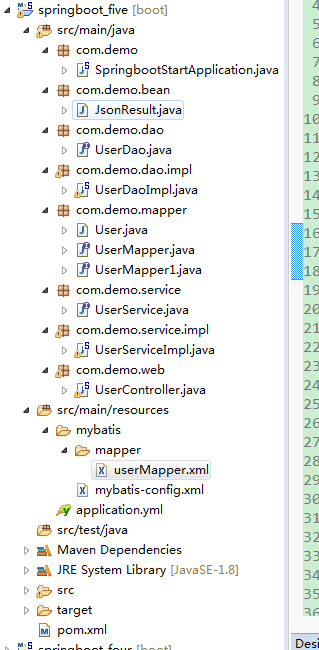一:项目结构:

二:pom文件如下:
<parent> <groupId>org.springframework.boot</groupId> <artifactId>spring-boot-starter-parent</artifactId> <version>2.0.4.RELEASE</version> </parent> <dependencies> <!-- Spring-Mybatis --> <dependency> <groupId>org.mybatis.spring.boot</groupId> <artifactId>mybatis-spring-boot-starter</artifactId> <version>1.3.0</version> </dependency> <!-- jdbcTemplate --> <dependency> <groupId>org.springframework.boot</groupId> <artifactId>spring-boot-starter-jdbc</artifactId> </dependency> <!-- MySQL连接 --> <dependency> <groupId>mysql</groupId> <artifactId>mysql-connector-java</artifactId> <scope>runtime</scope> </dependency> <!-- Add typical dependencies for a web application --> <dependency> <groupId>org.springframework.boot</groupId> <artifactId>spring-boot-starter-web</artifactId> </dependency> <dependency> <groupId>org.springframework.boot</groupId> <artifactId>spring-boot-starter-test</artifactId> <scope>test</scope> </dependency> </dependencies>
三:数据库配置:
spring:
datasource:
driver-class-name: com.mysql.jdbc.Driver
url: jdbc:mysql://192.168.1.20:3306/test
username: root
password: root123
四:代码说明:
最开始使用mybati比较麻烦,各种配置文件、实体类、dao层映射关联、还有一大推其它配置。当然mybatis也发现了这种弊端,初期开发了generator可以根据表结果自动生产实体类、配置文件和dao层代码,可以减轻一部分开发量;后期也进行了大量的优化可以使用注解了。
于是两种使用方式都介绍一下,一、无配置注解版 二、配置文件版
1.无配置文件注解版
加入配置文件
————————————————
实体类User.class package cn.saytime.bean; import java.util.Date; /** * @ClassName cn.saytime.bean.User * @Description * @date 2017-07-04 22:47:28 */ public class User { private int id; private String username; private int age; private Date ctm; public User() { } public User(String username, int age) { this.username = username; this.age = age; this.ctm = new Date(); } // Getter、Setter
package cn.saytime.mapper; import cn.saytime.bean.User; import org.apache.ibatis.annotations.Delete; import org.apache.ibatis.annotations.Insert; import org.apache.ibatis.annotations.Param; import org.apache.ibatis.annotations.Select; import org.apache.ibatis.annotations.Update; import java.util.List; // @Mapper 这里可以使用@Mapper注解,但是每个mapper都加注解比较麻烦,所以统一配置@MapperScan在扫描路径在application类中 public interface UserMapper { @Select("SELECT * FROM tb_user WHERE id = #{id}") User getUserById(Integer id); @Select("SELECT * FROM tb_user") public List<User> getUserList(); @Insert("insert into tb_user(username, age, ctm) values(#{username}, #{age}, now())") public int add(User user); @Update("UPDATE tb_user SET username = #{user.username} , age = #{user.age} WHERE id = #{id}") public int update(@Param("id") Integer id, @Param("user") User user); @Delete("DELETE from tb_user where id = #{id} ") public int delete(Integer id); ————————————————
UserService.class package cn.saytime.service; import cn.saytime.bean.User; import org.springframework.stereotype.Service; import java.util.List; /** * @ClassName cn.saytime.service.UserService * @Description */ public interface UserService { User getUserById(Integer id); public List<User> getUserList(); public int add(User user); public int update(Integer id, User user); public int delete(Integer id);
UserServiceimpl.class package cn.saytime.service.impl; import cn.saytime.bean.User; import cn.saytime.mapper.UserMapper; import cn.saytime.service.UserService; import org.springframework.beans.factory.annotation.Autowired; import org.springframework.stereotype.Service; import java.util.List; /** * @ClassName cn.saytime.service.impl.UserServiceImpl * @Description */ @Service public class UserServiceImpl implements UserService { @Autowired private UserMapper userMapper; @Override public User getUserById(Integer id) { return userMapper.getUserById(id); } @Override public List<User> getUserList() { return userMapper.getUserList(); } @Override public int add(User user) { return userMapper.add(user); } @Override public int update(Integer id, User user) { return userMapper.update(id, user); } @Override public int delete(Integer id) { return userMapper.delete(id); } }
JsonResult.class 通用json返回类:
package cn.saytime.bean; public class JsonResult { private String status = null; private Object result = null; public JsonResult status(String status) { this.status = status; return this; } // Getter Setter
UserController.class(Restful风格) package cn.saytime.web; import cn.saytime.bean.JsonResult; import cn.saytime.bean.User; import cn.saytime.service.UserService; import org.springframework.beans.factory.annotation.Autowired; import org.springframework.http.HttpStatus; import org.springframework.http.ResponseEntity; import org.springframework.web.bind.annotation.PathVariable; import org.springframework.web.bind.annotation.RequestBody; import org.springframework.web.bind.annotation.RequestMapping; import org.springframework.web.bind.annotation.RequestMethod; import org.springframework.web.bind.annotation.RequestParam; import org.springframework.web.bind.annotation.RestController; import java.util.List; /** * @ClassName cn.saytime.web.UserController * @Description * @date 2017-07-04 22:46:14 */ @RestController public class UserController { @Autowired private UserService userService; /** * 根据ID查询用户 * @param id * @return */ @RequestMapping(value = "user/{id}", method = RequestMethod.GET) public ResponseEntity<JsonResult> getUserById (@PathVariable(value = "id") Integer id){ JsonResult r = new JsonResult(); try { User user = userService.getUserById(id); r.setResult(user); r.setStatus("ok"); } catch (Exception e) { r.setResult(e.getClass().getName() + ":" + e.getMessage()); r.setStatus("error"); e.printStackTrace(); } return ResponseEntity.ok(r); } /** * 查询用户列表 * @return */ @RequestMapping(value = "users", method = RequestMethod.GET) public ResponseEntity<JsonResult> getUserList (){ JsonResult r = new JsonResult(); try { List<User> users = userService.getUserList(); r.setResult(users); r.setStatus("ok"); } catch (Exception e) { r.setResult(e.getClass().getName() + ":" + e.getMessage()); r.setStatus("error"); e.printStackTrace(); } return ResponseEntity.ok(r); } /** * 添加用户 * @param user * @return */ @RequestMapping(value = "user", method = RequestMethod.POST) public ResponseEntity<JsonResult> add (@RequestBody User user){ JsonResult r = new JsonResult(); try { int orderId = userService.add(user); if (orderId < 0) { r.setResult(orderId); r.setStatus("fail"); } else { r.setResult(orderId); r.setStatus("ok"); } } catch (Exception e) { r.setResult(e.getClass().getName() + ":" + e.getMessage()); r.setStatus("error"); e.printStackTrace(); } return ResponseEntity.ok(r); } /** * 根据id删除用户 * @param id * @return */ @RequestMapping(value = "user/{id}", method = RequestMethod.DELETE) public ResponseEntity<JsonResult> delete (@PathVariable(value = "id") Integer id){ JsonResult r = new JsonResult(); try { int ret = userService.delete(id); if (ret < 0) { r.setResult(ret); r.setStatus("fail"); } else { r.setResult(ret); r.setStatus("ok"); } } catch (Exception e) { r.setResult(e.getClass().getName() + ":" + e.getMessage()); r.setStatus("error"); e.printStackTrace(); } return ResponseEntity.ok(r); } /** * 根据id修改用户信息 * @param user * @return */ @RequestMapping(value = "user/{id}", method = RequestMethod.PUT) public ResponseEntity<JsonResult> update (@PathVariable("id") Integer id, @RequestBody User user){ JsonResult r = new JsonResult(); try { int ret = userService.update(id, user); if (ret < 0) { r.setResult(ret); r.setStatus("fail"); } else { r.setResult(ret); r.setStatus("ok"); } } catch (Exception e) { r.setResult(e.getClass().getName() + ":" + e.getMessage()); r.setStatus("error"); e.printStackTrace(); } return ResponseEntity.ok(r); } }
Application.java package cn.saytime; import org.mybatis.spring.annotation.MapperScan; import org.springframework.boot.SpringApplication; import org.springframework.boot.autoconfigure.SpringBootApplication; @SpringBootApplication @MapperScan("cn.saytime.mapper") public class SpringbootMybaitsApplication { public static void main(String[] args) { SpringApplication.run(SpringbootMybaitsApplication.class, args); }
测试:
使用PostMan通过测试: http://localhost:8080/user/1
2.配置文件版
加入配置文件

代码部分,相比于上面那种方式,改变的只有配置文件以及下面几个部分UserMapper.class
package cn.saytime.mapper; import cn.saytime.bean.User; import org.apache.ibatis.annotations.Delete; import org.apache.ibatis.annotations.Insert; import org.apache.ibatis.annotations.Param; import org.apache.ibatis.annotations.Select; import org.apache.ibatis.annotations.Update; import org.springframework.stereotype.Repository; import java.util.List; /** * @ClassName cn.saytime.mapper.UesrMapper * @Description */ @Repository public interface UserMapper { User getUserById(Integer id); public List<User> getUserList(); public int add(User user); public int update(@Param("id") Integer id, @Param("user") User user); public int delete(Integer id); }
UserServiceImpl类:
import java.util.List;
import org.springframework.beans.factory.annotation.Autowired;
import org.springframework.stereotype.Service;
import com.demo.dao.UserDao;
import com.demo.mapper.User;
import com.demo.mapper.UserMapper1;
import com.demo.service.UserService;
@Service
public class UserServiceImpl implements UserService{
@Autowired
private UserDao userDao;
@Autowired
private UserMapper1 userMapper;
@Override
public User getUserById(Integer id) {
return userMapper.getUserById(id);
}
@Override
public List<User> getUserList() {
return userMapper.getUserList();
}
}
mybatis-config.xml <?xml version="1.0" encoding="UTF-8" ?> <!DOCTYPE configuration PUBLIC "-//mybatis.org//DTD Config 3.0//EN" "http://mybatis.org/dtd/mybatis-3-config.dtd"> <configuration> <typeAliases> </typeAliases> </configuration>
userMapper.xml <?xml version="1.0" encoding="UTF-8"?> <!DOCTYPE mapper PUBLIC "-//mybatis.org//DTD Mapper 3.0//EN" "http://mybatis.org/dtd/mybatis-3-mapper.dtd"> <mapper namespace="cn.saytime.mapper.UserMapper" > <resultMap id="BaseResultMap" type="cn.saytime.bean.User" > <id column="id" property="id" jdbcType="INTEGER" /> <result column="username" property="username" jdbcType="VARCHAR" /> <result column="age" property="age" jdbcType="INTEGER" /> <result column="ctm" property="ctm" jdbcType="TIMESTAMP"/> </resultMap> <sql id="Base_Column_List" > id, username, age, ctm </sql> <select id="getUserList" resultMap="BaseResultMap" > SELECT <include refid="Base_Column_List" /> FROM tb_user </select> <select id="getUserById" parameterType="java.lang.Integer" resultMap="BaseResultMap" > SELECT <include refid="Base_Column_List" /> FROM tb_user WHERE id = #{id} </select> <insert id="add" parameterType="cn.saytime.bean.User" > INSERT INTO tb_user (username,age,ctm) VALUES (#{username}, #{age}, now()) </insert> <update id="update" parameterType="java.util.Map" > UPDATE tb_user SET username = #{user.username},age = #{user.age} WHERE id = #{id} </update> <delete id="delete" parameterType="java.lang.Integer" > DELETE FROM tb_user WHERE id = #{id} </delete> </mapper>
测试方法同上:http://localhost:8080/user/1
五、简要说明:
不知道大家有没有注意到一点,就是引入Springboot-mybatis依赖的时候,并不是spring官方的starter,往常的springboot集成的依赖,比如web,redis等,groupId以及artifactId的地址如下:
<dependency>
<groupId>org.springframework.boot</groupId>
<artifactId>spring-boot-starter-web</artifactId>
</dependency>
而这里是mybatis为spring提供的starter依赖,所以依赖地址是:
<dependency>
<groupId>org.mybatis.spring.boot</groupId>
<artifactId>mybatis-spring-boot-starter</artifactId>
<version>1.3.0</version>
</dependency>
而且值得注意的是,这里必须要指定版本号,往常我们使用springboot之所以不需要指定版本号,是因为我们引入的Maven Parent 中指定了SpringBoot的依赖,SpringBoot官方依赖Pom文件中已经指定了它自己集成的第三方依赖的版本号,对于Mybatis,Spring官方并没有提供自己的starter,所以必须跟正常的maven依赖一样,要加版本号。
————————————————